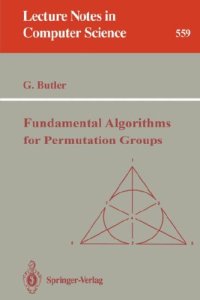
Ebook: Fundamental Algorithms for Permutation Groups
Author: G. Butler (eds.)
- Genre: Computers // Algorithms and Data Structures
- Tags: Symbolic and Algebraic Manipulation, Algorithm Analysis and Problem Complexity, Combinatorics, Group Theory and Generalizations
- Series: Lecture Notes in Computer Science 559
- Year: 1991
- Publisher: Springer-Verlag Berlin Heidelberg
- City: Berlin; New York
- Edition: 1
- Language: English
- pdf
This is the first-ever book on computational group theory. It provides extensive and up-to-date coverage of the fundamental algorithms for permutation groups with reference to aspects of combinatorial group theory, soluble groups, and p-groups where appropriate. The book begins with a constructive introduction to group theory and algorithms for computing with small groups, followed by a gradual discussion of the basic ideas of Sims for computing with very large permutation groups, and concludes with algorithms that use group homomorphisms, as in the computation of Sylowsubgroups. No background in group theory is assumed. The emphasis is on the details of the data structures and implementation which makes the algorithms effective when applied to realistic problems. The algorithms are developed hand-in-hand with the theoretical and practical justification.All algorithms are clearly described, examples are given, exercises reinforce understanding, and detailed bibliographical remarks explain the history and context of the work. Much of the later material on homomorphisms, Sylow subgroups, and soluble permutation groups is new.
This is the first-ever book on computational group theory. It provides extensive and up-to-date coverage of the fundamental algorithms for permutation groups with reference to aspects of combinatorial group theory, soluble groups, and p-groups where appropriate. The book begins with a constructive introduction to group theory and algorithms for computing with small groups, followed by a gradual discussion of the basic ideas of Sims for computing with very large permutation groups, and concludes with algorithms that use group homomorphisms, as in the computation of Sylowsubgroups. No background in group theory is assumed. The emphasis is on the details of the data structures and implementation which makes the algorithms effective when applied to realistic problems. The algorithms are developed hand-in-hand with the theoretical and practical justification.All algorithms are clearly described, examples are given, exercises reinforce understanding, and detailed bibliographical remarks explain the history and context of the work. Much of the later material on homomorphisms, Sylow subgroups, and soluble permutation groups is new.